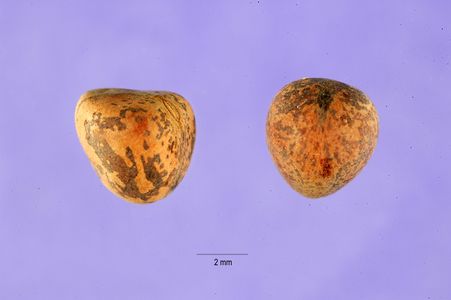Ervilia sativa
Ervilia sativa Link
| Ordre | Fabales |
|---|---|
| Famille | Fabaceae |
| Genre | Ervilia |
2n = 14
Origine : Méditerranée, Asie centrale
sauvage et cultivé
| Français | ers |
|---|---|
| Anglais | bitter vetch |
- fourrage
- légume sec
Sommaire
Description
Noms populaires
| français | ers |
| anglais | bitter vetch, ervil |
| allemand | Linsenwicke, Steinlinse |
| italien | ervo, moco, girlo |
| espagnol | alacarceña, yero |
| portugais | ervilha de pombo, gêro, orobo |
| polonais | wyka soczewicowata (Podbielkowski) |
| russe | француская чечевица - francuzskaja čečevica, горошек четкообразный - gorošek cvetkoobraznyj (Podbielkowski) |
| turc | kara burçak |
| arabe | karsanna |
- Voir les noms de la Flore populaire d'Eugène Rolland
Classification
Ervilia sativa Link (1822)
basionyme :
synonyme :
- Ervum ervilia L. (1753)
- Vicia ervilia (L.) Willd. (1802)
Cultivars
Histoire
Usages
Cultivated as a minor crop of diminishing importance in the Mediterranean area, in Near and Middle East countries, formerly also in southern parts of Central Europe and sometimes in western USA, recent main producer is Turkey, from which grains are exported to W Europe. It is used mainly as forage plant (green foder, grains, especially for sheep). Earlier it had been used for human food, too, but since Roman times it is mainly an animal feed. V. ervilia belongs to the old Near East crop assemblage, prehistoric remains are known from the 7/6th mill. BC from Anatolia and Greece, later also from Bulgaria and the Transcaucasus. The past centre of cultivation included the Levante, Turkey, SE Europe and domestication took place presumably in Anatolia. Here is also the centre of variation of this crop. The infraspecific variation (flower colour, number of flowers per raceme, size and colour of the pods, number of seeds, size, shape and colour of seeds, leaf characters) had been described by Barulina (1930).
Références
- Amigues, Suzanne, 2007. L’exploitation du monde végétal en Grèce classique et hellénistique. Essai de synthèse. Topoi, 15 (1) : 75-125. doi : 10.3406/topoi.2007.2233 et en ligne sur Persée
- Chauvet, Michel, 2018. Encyclopédie des plantes alimentaires. Paris, Belin. 880 p. (p. 414)
- Luce, J.-M., 2000. De l’ers ou du bonheur chez les bœufs. Pallas, 52 : 109-114.
- Schaefer, H. et al., 2012. Systematics, biogeography, and character evolution of the legume tribe Fabeae with special focus on the middle-Atlantic island lineages. B. M. C. Evol. Biol., 12 : 250. 19 p. Evol. Biol. ou doi : 10.1186/1471-2148-12-250

